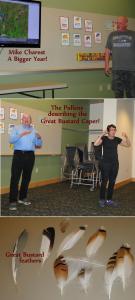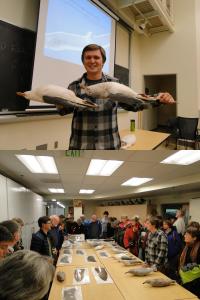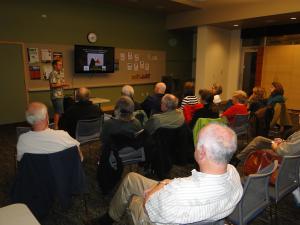JANUARY 2015 ABC GALA!
On January 29th, the ABC Club met to celebrate its own!! We had lots of fun and games, beverages, and goodies!
The meeting started out with the two stalwarts of the club, Kay Pullen, our Mistress of Ceremonies and program planner, and Ken Brown, founder, both being recognized this year by Tahoma Audubon as award winners for their volunteer work! Congratulations both of you!
Kay then announced a wonderful roster of upcoming programs including feather artist Chris Maynard next month on February 26, famous woodpecker and owl photographer/author Paul Bannick on March 23, noted naturalist and author Andy Stepniewski in April, Wendy Connally of WDFW in May or June on the new Northwest eBird portal, later in the year Lora Leschner of the Washington Pacific Cost Joint Venture, then Peter Wimberger and Dennis Paulson, whom you all know!
Plus we’re going to read the book, The Thing with Feathers by Noah Strycker, a one-time Washingtonian who is now doing a World Big Year! More info: http://noahstrycker.com/ So start reading soon!
Our Big Year review included our star for Pierce County, Mike Charest, with what he’s learned from two consecutive Big Year titles and the new birds added for 2014. His photos, as usual, were terrific! He also explained where Sha-Dux wetland is, one of his finds that got people birding there and where there is currently a Black Phoebe! The Phoebe was seen yesterday by the red mark: https://www.google.com/maps/place/47%C2%B013%2717.7%22N+122%C2%B020%2746.5%22W/@47.2217396,-122.3460782,976m/data=!3m1!1e3!4m2!3m1!1s0x0:0x0
The Great Bustard Caper was then presented by Kay and Ed Pullen. This was on a trip to England where they were privileged to be privy to a reintroduction program of this fabled huge bird to the Isles from Spain after a botched attempt from Russia. The population now is almost to the self-sustaining level. The leader of the program has facial hair now making him quite resemble a Great Bustard himself and keeps Bustard “pets” which the Pullens met and came home with souvenir feathers, some of which they offered to us, some saved for Faye, our Feather person, and some to be saved for next month’s speaker, the feather artist/expert Chris Maynard!! The feathers illustrated powder down very well. Ed recommended YouTube videos for more information:
Then the game quiz!! We struggled and we laughed to identify problem bird photos! Photos came from many of the group. As usual, we sweated over them too long, so had to postpone many for another day.
Our 5 Best Photos of 2014 participants showed us some glorious photos, including the Pullens, Pat Damron, Heather Roskelley, Heather Voboril, Susan Boynton, Carol Smith, John Riegsecker, Brian Pendleton, Vicki Biltz, John Riegsecker, Bryan Hanson, Diane Y-Q, Åsta Tobiassen, and Cara Borre, including her stunning video of the Eurasian Hobby seen in October/November, which was part of a longer video on the great bird collection seen at that time at Neah Bay, which is highly recommended: https://www.youtube.com/user/wildthingproduction1?feature=watch
A great time was had by all!
Click below to enlarge photos:





